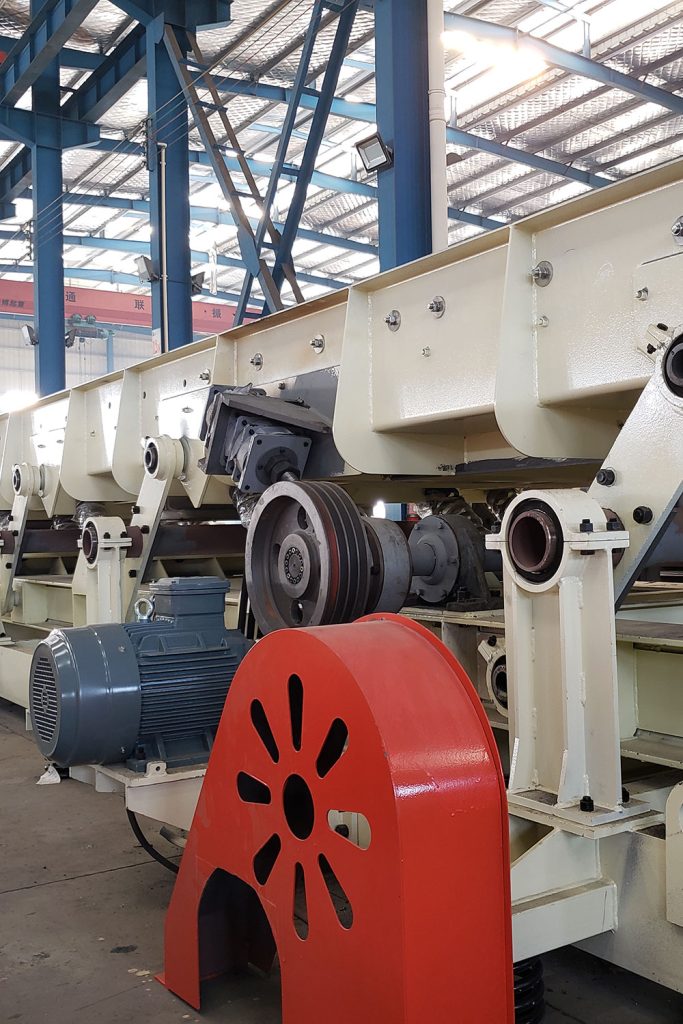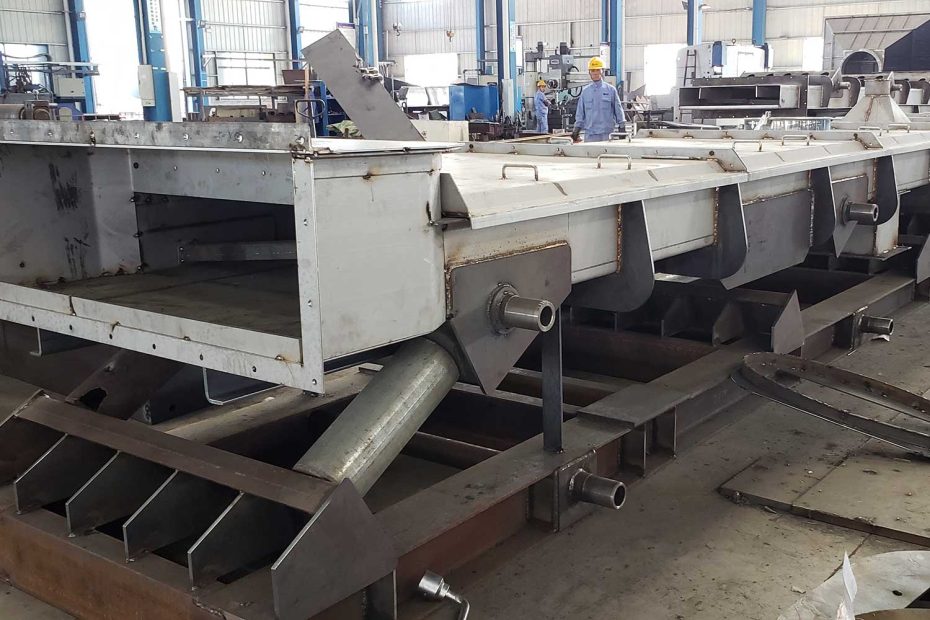Vibratory or oscillating conveyors can be found in all types of industry, handling virtually any granular bulk material. They can be combined with other process functions, such as screening, cooling, drying and de-watering, while conveying. The conveyor can be covered and made dust-tight.
Vibrating conveyors
Vibrating conveyors are commonly employed in industry to carry a wide variety of particulate and granular types of bulk materials. The fundamental action of the vibrating troughs on the bulk material loaded on it is to throw the particles upward in the forward direction so that the material performs a series of short hopping movements and propagates at a certain speed.
Basic vibratory conveyor designs

- Conveying element,
- The inertial mass of an object.
- Framework,
- Floor,
- The elasticity of the element carrying the load relative to the frame,
- Between the conveyance element and the frame, there is a guide mechanism.
- The elastic modulus of the conveying element in relation to the inertial mass.
- A mechanism that acts as a guide between the transporting element and inertia,
- An exciter of vibration connected to a conveying device,
- Exciter for vibrations applied to the inertial mass,
- A vibration exciter in between the carrier and inertia,
- Arrays of buffers.
Vibratory conveyors’ conveying components are often configured as pipes, cylindrical or conical drums, or rectangular channels. Due to the simplicity and dependability of this kind of construction, the carrier’s guiding mechanism relative to the frame or inertia is often built as a parallelogram.
Leaf springs or helical springs are often used to connect the conveying element to the frame or inertia. The inertia mass is resiliently connected to the carrier on one side and to the frame on the other. This is often used to impart a desired motion to the conveying element or to minimize the transfer of unwanted vibrations to the frame and surrounding area. Additionally, tuning stability is a concern when using an inertia mass.
The frames of vibratory conveyors / Oscillating conveyors are typically welded or cast and are often supported by rubber springs with reasonably high stiffness. In certain instances, frames are attached to the floor by stiff connections, such as screw anchors. No rubber sprigs are used in these instances.
Excitation is accomplished via eccentric motors or electromagnetic vibration exciters. External vibration exciters are rotors that are naturally unbalanced and may be linked to either the conveying element or the inertial mass. Typically, an electromagnetic oscillation exciter is attached to energize a spring. The split core is connected to the inertial mass on one side and to the conveying element on the other.
Oscillating conveyors
Oscillating conveyors are utilized to convey sand or other granular particles at a desired rate. The conveyor is generally placed under a vibrating shakeout or a grid to eliminate direct handling of hot sand by the belt conveyor. In the process of reciprocation, the oscillating conveyor cools the hot sand to some extent which increases the life of the return sand conveyor belt.
Oscillating conveyors are often known as jump conveyors or grass hopper conveyors in hard rock mining applications.
Principle
The oscillating motion is accomplished by specially designed inclined arms and an eccentric shaft driven by a motor through V-belts. The eccentric shaft is mounted on antifriction bearings and has V-pulleys at both ends with weights on them to counteract the unbalancing force. The rotation of the eccentric shaft provides a forward and backward motion to a connecting arm attached to the trough through a rubberized pin. The trough motion is predominantly horizontal with some vertical component, which causes it to oscillate with a pattern that moves material. A retaining spring assembly at the back of the trough absorbs the shock load. All components including the drive motor are mounted on a rigidly constructed base frame.
Applications
Oscillating conveyors are often referred to as a particular form of vibrating conveyor when they work with a relatively low frequency and a greater range of motion than would be normally used with a vibration conveyor. Oscillating conveyors can be used to transport toxic or chemically aggressive material through a closed trough or pipe in chemical, metallurgical and mining industries. They are also used to transport steel chips in a machine shop, hot knocked out sand, wastes and small castings in a foundry shop.
- Vibratory conveyors find widespread application in the transportation of dusty, hot, toxic, and chemically aggressive bulk material through a closed trough or pipe in chemical, metallurgical, mining industries, and manufacturing of building materials.
- Vibratory conveyors are also employed for transportation of steel chips in the machine shops, hot knocked out sand, wastes, and small castings in foundry shops. Vibratory feeders are also in use for the delivery of small machine parts like screws, rivets, etc.
- Sticky materials like wet clay or sand are unsuitable for vibratory conveyors. In handling finely pulverized materials, like cement, etc., the performance of such conveyors is reported to be poor.
- Vibratory conveyors are hardly employed for handling common bulk loads, such as sand, gravel, coal, etc as the same can be done more efficiently by belt conveyors.
Advantages
Hot and abrasive materials can be handled
Cooling, drying, and dewatering operations can be done during transport
Scalping, screening, or picking can be done
Units can be covered and made dust tight
Simple construction and low headroom
Can be made leakproof
Disadvantages
- The relatively short length of conveying ( about 50 m Maximum)
- Limited capacity, about 350 tons per hour for a length of conveying of 30 m.
- Some degradation of material takes place.
Difference between Vibrating Conveyor vs Oscillating Conveyor
Oscillating conveyors are often referred to as a particular form of vibrating conveyor when they work with a relatively low frequency and a greater range of motion than would be normally used with a vibration conveyor.
This means that oscillating conveyor systems are utilized for the transmission of bulk commodities such as in the wood or waste management/recycling industries. These conveyors, for instance, can be used to carry wooden scraps upstream and transfer them to an outlet.
In contrast to vibrating conveyors operating at lower amplitudes and higher frequencies, the flow or transportation of the substance is softer with a vibrating conveyor than with an oscillating conveyor. Oscillating conveyors are often known as jump conveyors or grasshopper conveyors in hard rock mining applications.
Sources: “Oscillating Conveyor System | Vibratory Conveyor or Oscillating System | Vibrating Conveyor Applications “, BlogMech, Visited 14 Aug, https://blogmech.com/oscillating-conveyor-vibratory-conveyor/
